N.B. I posted a blog in April 2019 with new information that seems
to confirm his real name was Kurt Karl Goose
On rare occasions I get distracted by the stories I encounter which are technically peripheral to my research into Josef Jakobs. One of those stories is that of double agent GANDER (GOOSE).
Information on GANDER is sketchy at best. There is no MI5 file on him in the National Archives, which is rather odd. References to GANDER in the literature are short but the basic line of the story is this:
GANDER was a German soldier who landed near Wellingborough (Northamptonshire) in early October 1940. He was apprehended by local farmers and eventually taken to Camp 020 where he admitted that he had been recruited to report on the weather, morale and road blocks. He told Major Robin W.G. Stephens, commandant of Camp 020, that he had no intention of carrying out his mission but wanted to get back to America where he had spent several years as a student. He quickly agreed to serve as a double agent. Unfortunately, his wireless radio set could only transmit, not receive, so after several weeks, he was retired as a double agent, being of limited value to MI5.
Modern Rumours about GANDER
For decades, the story of the German parachutist spy has been told and retold in the Wellingborough area and makes for interesting reading. In 2005, the village of Wellingborough published a 60th Anniversary Souvenir edition of their newspaper. Naturally, it included a piece on the spy:

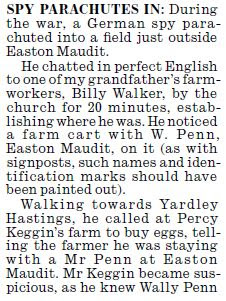
“He chatted in perfect English to one of my grandfather’s farm workers, Billy Walker, by the church for 20 minutes, establishing where he was. He noticed a farm cart with W. Penn, Easton Maudit, on it (as with signposts, such names and identification marks should have been painted out).
Walking towards Yardley Hastings, he called at Percy Keggin’s farm to buy eggs, telling the farmer he was staying with a Mr. Penn at Easton Maudit. Mr. Keggin became suspicious as he knew Wally Penn kept chickens, and so alerted the police.”

“The spy was found hiding in a ditch and arrested. His belongings included a suitcase full of money and maps of the Coventry area. His task was to have identified Coventry-based munitions factories in preparation for a bombing mission.
Billy Walker, who was in the Home Guard, was later teased about his encounter with the German, especially as he had been awarded the Military Cross in the First World War.
The spy was taken to Bedford Prison, where he was hanged.”
(piece was written by Cllr. Tim Allebone)
Makes for fascinating reading, doesn’t it? Unfortunately, most of the details in the story are not accurate. So let’s see what facts we can unearth about this mystery spy.
GANDER’S Real Name
Right off the bat, we run into trouble. Various names are ascribed to the man known as GANDER. His forged British Identity card was in the name of Alfred Philips, obviously an alias. GANDER also carried his personal army pay book which apparently listed his name as some variation of Kurt/Karl Grosse/Gross/Goose. Apparently at one point, MI5 was going to codename him GOOSE and that name may have stuck as being his last name.
In 1981, Nigel West noted that GANDER’s real name was Hans Reysen/Reisen. This was based on what Wulf Schmidt had told MI5 interrogators but would seem to contradict the information in GANDER’S army pay book. For the moment, let’s just call our spy Karl Gross.
Early Life
Karl was born on 12 June 1911 in Berlin. He studied geology and mining in Berlin, studies that were interrupted in 1935 by two 8-week periods of infantry training. In 1936, Karl travelled to America and continued his geological studies at the University of California. With the declaration of war in September 1939, Karl embarked on an adventurous trek to get back to Germany. He eventually succeeded in May 1940, arriving back in his home country via Japan.
As an able-bodied young man (29 years old), Karl was immediately called up into the Army. His fluency in English meant that he was a prime candidate for the Brandenburg Lehr-Regiment s.b.V 800. The Lehr Regiment was an offshoot of the German Abwehr (Intelligence Service) and was composed of men fluent in a variety of languages. The regiment was an intelligence and sabotage unit, but Karl wouldn’t remain with them for long. One day, his Sergeant asked the men who was fluent in English. Karl put up his hand and was sent off to Brussels for espionage training.
In Brussels, Karl underwent three weeks of wireless training and learned the finer details of weather reporting. He met fellow spies Wulf Schmidt (TATE) and Gosta Caroli (SUMMER) during this period. Karl apparently told Schmidt that he knew capture meant a date with the executioner. Karl said he was going to bring his German Army pay book and a Luftwaffe uniform in order to be able to claim he was a Prisoner of War and not a spy.
Caroli and Schmidt parachuted separately into England in early to mid September but both were quickly captured and turned by the English. Schmidt and Caroli both admitted that they had met a man named Hans Reisen who was being trained to come to England. Reisen was 37 years old, spoke English with an American accent and was from Bremen. According to Schmidt, Reisen would be equipped with a National Identity card whose registration number began with CNFS, part of a bogus series of numbers sent to the Germans by double agent SNOW.
Dropped into England
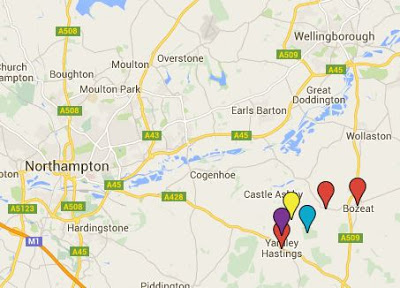
Red markers – villages of Yardley Hastings, Bozeat and Easton Maudit. Blue marker – possible location of Hollowell Plantation (close to Easton Maudit and about 1 mile from Len Smith’s place) – landing site of GANDER
Purple marker – location where Len Smith met Karl.
Yellow marker – Percy Keggin – The Lodge farm.
On the evening on 3 October, 1941, Karl leapt from an airplane over Northamptonshire. Unlike many other parachute spies, Karl made an uneventful landing southwest of Wellingborough.
When dawn arrived, Karl cut up his parachute and harness and stuffed the pieces in various rabbit holes. The weather was not all that conducive to living rough and after reconnoitring for a few hours, Karl changed into civilian clothes, stuffed the rest of his gear under a number of bushes and took shelter in a farmer’s barn about a mile from where he had landed. It wasn’t the smartest move.
At about 6:30 pm, Thomas Leonard Smith of Yardley Hastings went to visit his farm buildings on Grendon Road. When he entered one of the buildings, he found Karl. Immediately suspicious of the stranger, Smith asked Karl what he was doing in there. Karl said that he was sheltering from the rain but thought that the weather had improved and said “I think I will be going”. Smith asked Karl where he had come from and Karl eventually admitted that he had come from Harpenden to Bedford and arrived in Yardley Hastings on the bus. When asked where he was staying, Karl said that he was staying about a mile and a half along the road at a farm house, although he couldn’t remember its name. Smith’s suspicions got stronger and he told Karl that he would accompany him to this farm and asked to see his identity card. To Smith’s uneducated eye, the card looked genuine and the two men began to walk along Grendon Road.
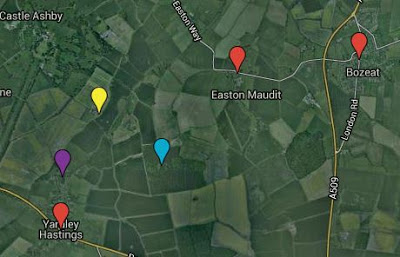
Red markers – villages of Yardley Hastings, Bozeat and Easton Maudit.
Blue marker – possible location of Hollowell Plantation (close to Easton Maudit and about 1 mile from Len Smith’s place) – landing site of GANDER.
Purple marker – location where Len Smith met Karl.
Yellow marker – Percy Keggin – The Lodge farm.
A short while later, Percy Keggin drove up behind the men and Smith stopped him and asked for help. He told Keggin he had found the man in one of his buildings and didn’t know what to do with him.
Keggin also took a look at Karl’s identity card and then asked him where he was going. Karl admitted that he wanted to go to a farm along Grendon Road. Since it was such a wet night, Keggin offered to drive Karl to the farm and both Smith and Karl climbed into the vehicle.
After driving almost as far as Grendon without finding Karl’s farm, the men returned to Keggin’s house, The Lodge (also on Grendon Road). Tucked in the warmth of the kitchen, Keggin mentioned the names of various farmers and Karl admitted it might have been Mr. Penn of Easton Maudit. Karl said that he had left his coat at the farm after staying there the previous night.
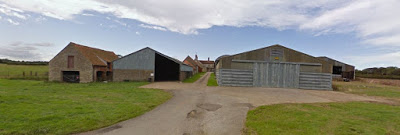
Keggin, relieved to finally have a solution to the lost man, telephoned William Reginald Penn in nearby Easton Maudit and told him that the man who had stayed at Penn’s farm the previous night was at his place and could he please come and fetch him as it was a wet night.
While Keggin and Smith were both rather simple farmers, William Penn was another matter entirely. Penn was head Air Raid Warden and a Section Leader for the Home Guard at Easton Maudit. After receiving the rather confusing phone call at about 7 pm, Penn rounded up Robert Ingram and drove off to Keggin’s farm. Penn took a look at Karl’s National Identity card and was immediately suspicious of its newness. He told Karl to come with him and he would “put him right”. Penn, Ingram and Karl all piled into Penn’s vehicle which he promptly drove to the Bozeat Police Station.
Arrested by the Police
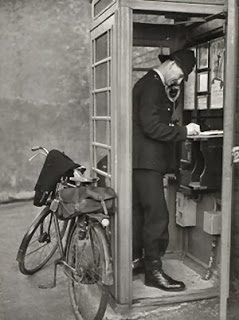
John William Forth, Police Constable (PC 23) responsible for policing that corner of Northamptonshire, had moved to the village of Bozeat in 1936. On the evening of 4 October, 1941, he and his wife were likely tucking their young daughter into bed. At about 7:35 pm, Walter Penn arrived at the station with Karl in tow. Penn told Forth that he was not satisfied with the man’s identity and so had brought him to the police.
Forth had a look at Karl’s Identity card which likely aroused the police constable’s suspicions. The card was dated 20 May, 1940, and Forth likey knew that cards should not bear a date prior to 21 May, 1940. Engaging in conversation with the man, Forth noted that he spoke with a foreign accent and that all of his clothing appeared to be new and of foreign origin. Karl told the constable that he had come to Yardley Hastings from Bedford by bus and was aiming to get a job in Kettering as a waiter.
Forth rang up Inspector Sharman and “kept the man under close observation” until Sharman arrived at 8:00 pm. While they were waiting, Forth’s wife took pity on the “very scared and hungry man” and cooked him a plate of scrambled eggs. Karl was “very polite” and “most grateful” for the food. He was clearly also very nervous for Forth’s wife noticed that he couldn’t stop playing the fringe of his scarf.
When Inspector Sharman arrived, things became very serious. Karl was subjected to a search and the following items were uncovered:
- Identity card – Alfred Phillips – FMEG 296/1
- several other identity cards
- small pistol
Karl quickly realized that the game was up and confessed that he had parachuted into England and landed near a pumping station. His mission was to transmit weather reports back to Germany. He agreed to take the police to his landing point and retrieve the rest of his gear. After being handcuffed to Constable Forth, Karl led the police to a pumping station near Hollowell Plantation (Hollow Well Planting), Easton Maudit. After getting his bearings, Karl led the police to some bushes beneath which he had stashed his equipment. Opening up the suitcase, the police officers found Karl’s Luftwaffe uniform and discovered that “he had had a rather embarrassing accident in his flight suit on the way down”.
Inspector Sharman took possession of Karl and his gear and took him to Wellingborough Police Station. The following day, Sharman and Forth returned to Hollowell Plantation and found some of the parachute and parachute harness pieces stuffed in various rabbit holes. These, along with Karl and his possessions, were all passed on to MI5. Constable Forth and his family never learned what happened to the scared and hungry spy. Wellingborough rumours suggested that he was hanged in Bedford Prison.
Off to Camp 020
On 5 October, 1941, Karl arrived at Latchmere House and was interrogated by Major Robin W.G. Stephens and his team of offices. Karl put up no resistance. He told the story of his recruitment into the Abwehr. He said that he had had no intention of carrying out his mission, which was to report on the weather, morale and road blocks. He really just wanted to get back to America. Stephens and his crew were naturally skeptical since Karl was a fairly well-equipped spy.
His identity card was actually a pretty good forgery and didn’t use any of the numbers sent over by SNOW. There were no continental characteristics to the writing and the name was actually entered in the correct order (last name first). But there were still a few errors. The name was entered with only a first initial which was not accurate. It should have been “Phillips, Alfred” not “Phillips, A.”. And the date was a giveaway as well.
Rifling through Karl’s gear, the MI5 officers also found:
- £114 (not £500 as reported by some authors)
- wireless transmitter (#40) but no receiver
- grid code – likely similar to those of Waldberg, Meier, Kieboom and Pons
- British Passport – in the name of Alfred Phillips
- British Identity card – A. Phillips – FMEG 296/1
- Ration Card – A. Phillips
- British Identity card – blank
- German Army pay book in his own name
- automatic pistol and ammunition
- road map of Great Britain
- Luftwaffe uniform
- barometer
- compass
- reagent for secret writing
According to Guy Liddell, MI5 proposed to use GANDER as an obvious double-cross in order to enhance the status of SUMMER. On 8 October, 1940, Liddell noted that one of MI5’s radio operatives, Ronnie Reed, was going to work with Karl in composing a message to send to the Abwehr. A radio operator’s Morse code sending pattern (his “fist”) was as unique as his voice and MI5 was going to have Reed send the message using GANDER’s wireless set. In theory, the Abwehr would hear the message, recognize that the sender was not Karl and realize that he had been turned into a double agent. This would hopefully lend more credence to the authenticity of SUMMER and TATE. Liddell acknowledged that Karl was “a poor fish who never wanted to be a spy.” One naturally wonders what would have happened to Karl’s family if the Abwehr suspected that he had betrayed them.
While the radio message was being prepared, Karl was put in a room with Karl Meier, one of the spies who had landed on the Kent coast in early September. The two men talked about political events and the interrogation process, recognizing that they were being squeezed for information and were likely to be tossed in the “wastepaper basket” once they were dry.
Once the message for Karl had been prepared, he and Reed attempted to send it to Germany. Unfortunately, MI5 was unsuccessful in establishing contact with the Abwehr using Karl’s set and, after three weeks, he was retired from the double agent crew. Since Karl’s set could not receive messages from the Abwehr, one wonders how contact with the Abwehr could be called “unsuccessful”.
While a prisoner at Camp 020, Karl tarnished his reputation by trying to bribe a soldier guard to smuggle a letter to the German embassy in Dublin. Karl was extremely lucky. MI5 drew up a Treachery Act case against him and he only escaped death by the narrowest of margins. In November 1941, Swinton, MI5, the Director of Public Prosecutions and the Attorney General met to discuss the cases of “tarnished” double agents (SUMMER and GANDER). They eventually agreed that no question of prosecution could arise if MI5 had used an agent or given him a promise. Firstly, there was always the danger that secrets of the double agent system could be revealed at trial and secondly, and perhaps rather belatedly, “a promise once given had to be honoured.”
Karl was transferred to Camp 020R (Huntercombe) for the duration of the war. According to MI5 files, Karl was sent to Diest (Belgium) on 2 July 1945. What became of him after that is a complete mystery.
Naturally, it would be fascinating to see Karl’s actual KV 2 file… perplexing why that has not yet been released by MI5.
N.B. 2021 06 17 – as noted at the start of this blog, I have uncovered more information on Kurt Karl Goose (his real name was Goose not Gross).
References
Books
Agent TATE – 2011 – Tommy Jonason and Simon Ollsson
British Intelligence in the Second World War, Volume 4 – 1990 – F.H. Hinsley and C.A.G. Simkins.
Camp 020: MI5 and the Nazi Spies – 2000 – Oliver Hoare.
Double Agent Snow – 2013 – James Hayward
Guy Liddell Diaries, Volume 1 – 2009 – Nigel West
MI5: the True Story of the Most Secret Counterespionage Organization in the World – 1981 – Nigel West
Snow: the Double Life of a World War II Spy – 2011 – Nigel West and Madoc Roberts
Unternehmen Seelöwe – 2014 – Monika Siedentopf
National Archives files
KV 2/12 – Security Service file on Karl Meier
KV 2/114 – Security Service file on Engelbertus Fukken (Willem ter Braak)
KV 2/449 – Security Service files on Arthur Owens (SNOW)
KV 2/2593 – Cases at Camp 020
KV 4/8 – Sampson’s History of Camp 020
KV 4/16 – Report on MI5 Operations during the War
Websites
BBC – WW2 People’s War – The Village Policeman – article written by John E. Forth, son of PC 23, John William Forth – includes statements by Forth and the three farmers.
Bozeat – Village Bobby (same as the BBC Story) (N.B. 2021 06 17 – site no longer exists)
Bozeat History (N.B. 2021 06 17 – site no longer exists)
Wellingborough – WWII 60 Year Commemorative Edition (The Link 1945-2005).
Header image – “Footpath past the sewage works towards Easton Maudit” by Philip Jeffrey is licensed under CC BY-SA 2.0
